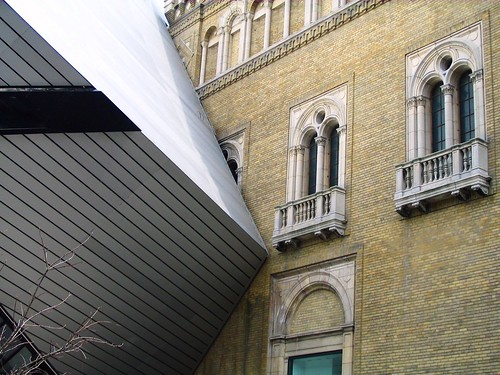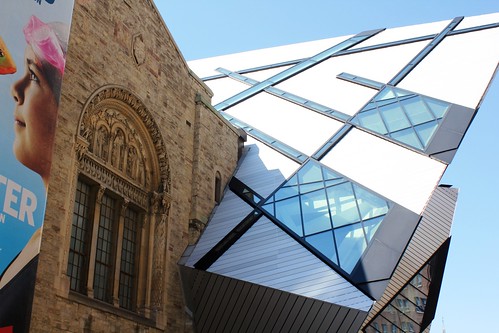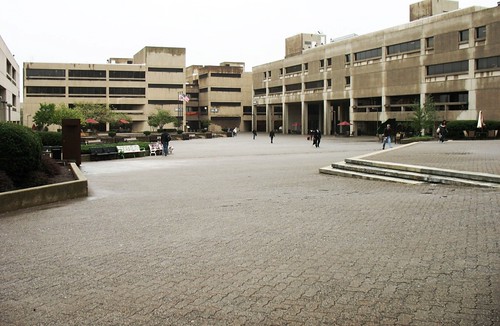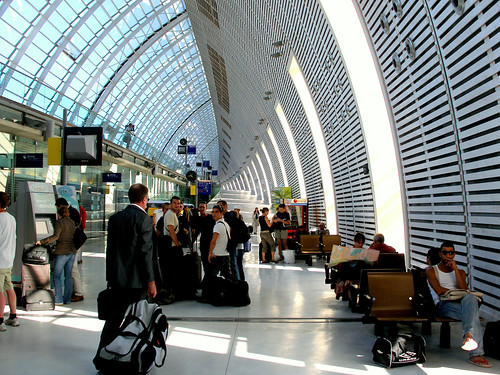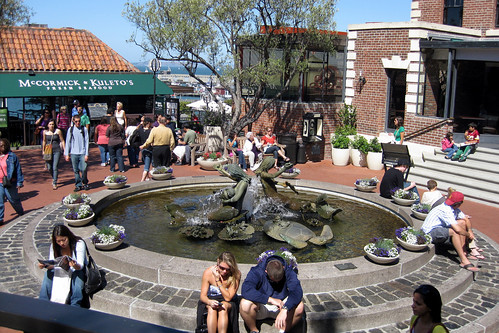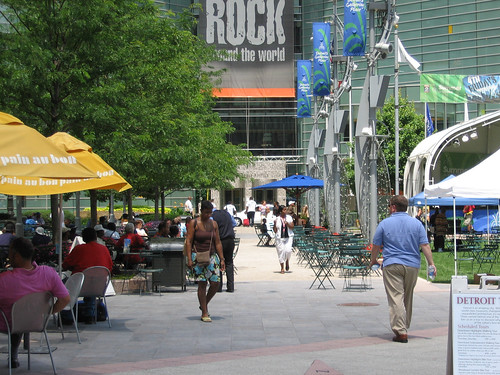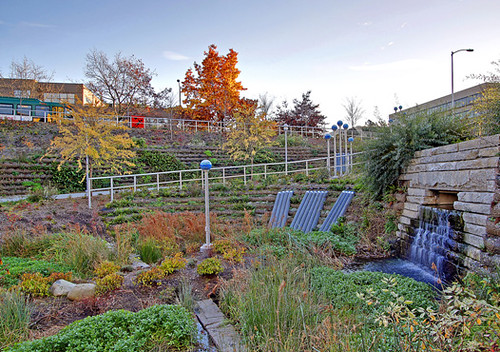Architecture, Public Responsibility, and the Art of Listening
I've been mulling this one for a few days. I seem to know a lot of people who do a lot of complaining about the architecture profession, particularly its alleged preoccupation with making artistic statements rather than, the charge goes, serving people. I think it's a fair point to a degree, but for a lot of reasons I'll try to work through here, I'm having a hard time figuring out to what degree, exactly. A related issue is the extent to which architects should, and do, listen to the people their buildings and places are supposedly serving.
Has architecture lost touch with people?
The issue was brought into clear focus a few days ago when I ran across an article written by Christine Outram, "senior inventionist" at Deutsch LA, in an online publication called Medium. The article, a short but scathing indictment of architecture today, is provocatively titled, "What Starbuck's Gets that Architects Don't, or Why I Left the Architecture Profession." Here's a sample:
"In legal terms, an architect is the all seeing, all knowing, building professional. You are liable for anything that goes wrong with a building but if someone just hates the spaces you design? If someone feels uncomfortable, or cold, or scared? Well there's no lawsuit for that . . .
"The problem is that architects seem to pray at the feet of the latest hyped-up formal language. I dare you. Flip through an architectural magazine today. Find any people in the photographs? I didn't think so. Find plenty of pictures that worship obscure angles and the place where two materials meet? You betcha."
Outram contrasts "architecture" with Starbuck's, which she says conducted extensive market research before learning from potential customers that their product should be not just about coffee but also about providing spaces for people to hang out, which in turn led to a number of important design decisions. And, love them or hate them, you can't quarrel with the chain's immense success. I've seen hundreds of Starbuck's outlets but I can't recall ever coming across an empty one.
Once I get past the holier-than-thou tone of Outram's article, I do see some truth in it. My very first article for this blog contained a photo (above) of a vast, open plaza not far from my home that was dreary architecture, and nothing if not depressing. (It has since been updated for the better.) But at least that plaza, part of a university complex that suffers from 1970s brutalist design, was apparently well-intentioned. Some buildings seem aggressively offensive, intended to shock more than serve, as with Toronto's deconstructionist "Crystal," a six-year-old wing of the Royal Ontario Museum (see top photos); in my opinion, it desecrates the historic original museum building to which it attaches. I suppose it's a matter of taste, but to me the Crystal also jars rather than nourishes the human spirit. It's attention-getting, I guess; I'll give them that. (For the moment, I'll leave aside the question of whether the design concept would be more appealing in a different setting, detached from the original ROM building.)
Some nuances to consider
All that said, I believe the issues involved with today's architecture are a lot more nuanced than Outram acknowledges. First, I know lots of architects who are doing good, humanist, contextually sensitive design. Outram gives a passing nod to Jan Gehl in this regard, but only minimally. He's hardly the only one; this blog is full of great examples (such as here and here; more below).
Second, highly original, "statement" buildings and places are not inherently anti-human. One of my favorites is the modernist high-speed rail station just outside Avignon in France (photo just above). It's as much sculpture as rail depot, but it also is an utter delight to visit or pass through. In Washington, I love the way the modernist but reserved Embassy of Finland, with its clean lines, living wall and park-like setting, celebrates nature and the Scandinavian culture. The spacious interior with transparent views of the woods behind can be breathtaking. People flock to I.M. Pei's East Wing of Washington's National Gallery of Art, as much because of its striking architecture as the art it holds; from inside the building, Pei's expertly placed windows perfectly frame vistas of the national monuments.
Third, I'm not sure it's fair to compare retail to other kinds of architecture. Most of the cold, lifeless architecture I see is corporate or institutional. Retail establishments such as Starbuck's are in the business of attracting customers and, if they have adequate resources and the location is right for business, I'd say they succeed at that more often than not. It may not be Great Architecture, but it works for people. Consider the amazing success of the enclosed suburban regional shopping mall, for example. The exterior architecture is generally hideous, as are the parking lots; but, on the inside, designers figured out exactly what people wanted. We now know that the results haven't been so good for America, in my opinion, and the mall as an architectural form is now in significant decline. But it had quite a run over four decades or so.
Starbuck's may prove to have a limited run as well. But it isn't surprising that the chain has paid more attention to the experience of visitors than might, say, a corporate headquarters.
Fourth, for buildings that are not specifically designed to attract the general public, the questions start to get messier. Architects don't work for themselves but for clients. For an architect to create a sympathetic, humanist building, she needs not just talent and ethics but also a sympathetic, humanist (or very trusting) client. I suspect that clients are often driving the decisions about what kinds of buildings get designed and constructed.
Does architecture have an ethical responsibility to the public?
The most interesting question to me is to what extent an architect and client have a responsibility not just to the client's parochial interests but to the broader interests of the public. Given how sacred private property rights are in this country, this is very tricky territory. Clearly, the public has some interests that are recognized legally. That's why we have zoning (for better or worse), for example.
But is there a public interest beyond what is legally required? Does an architect have an ethical duty to the public? Outram seems to suggest that he or she does have such a duty, or at least that the world would be a better place if architects acted as if there were one. Some cases are easier than others: a public courthouse, for example, is clearly part of the commons, and should be designed with that in mind; a private residence on a remote lot, not so much. But what about a prominent but private office building on a downtown corner? What about a cluster of buildings on a redevelopment site close to downtown? What about private property intended for public use, as is the case with New York's renowned Rockefeller Center or San Francisco's Ghirardelli Square? Nearly all commercial, civic, and institutional architecture – at least exterior architecture – once built, becomes part of a community's collective experience, albeit to widely varying degrees.
If there is not already an architectural code of ethics that recognizes a responsibility to the commons, should there be? Outram's article suggests that an important part of an architect's practice should be taking the pulse of the public, or at least a wide swath of building users, as Starbuck's did with its market research. Should that sort of inquiry become standardized in some way?
The Charter of the New Urbanism – developed almost entirely by architects, by the way – provides one set of answers. It doesn't address the important public engagement issue, but it certainly provides a set of guidelines to govern the relationship of the built environment to people and to the public realm. The Charter has been supplemented by an urban-to-rural "Transect" in an attempt to translate the Charter's principles into more detailed guidelines according to a site's place within a larger region. (At this point I should add that I have been a member of the Congress of the New Urbanism almost as long as CNU has been in existence. I agree with just about all of what is in the Charter as an antidote to the tremendous harms wreaked by suburban sprawl on our environment, economy and social fabric. I don't always agree with the way new urbanism is practiced on the ground – particularly on greenfields – but I don't agree with all environmentalists all of the time, either.)
New urbanism has its detractors, of course. Environmentalists quarrel with some of its practitioners' disdain for environmental regulation and their sometimes noncritical view of expansionist greenfield development if they get to design it. (Clients, not architects, generally choose development location, it must be said.) Modernists quarrel with many (not all) new urbanist practitioners' adherence to traditional forms. Planners sometimes perceive a rigidity in the doctrine's precepts. But I would say that new urbanism is the best-articulated attempt out there to relate architecture to the commons, and to a set of humanist standards, until someone comes up with a better one.
Good placemaking stresses process and engagement
It was perhaps serendipitous that, on the same day that I read Outram's complaint that architects don't listen to the people their designs affect, I came across a new report out of MIT stressing the importance of process and engagement to good placemaking. The study, released by the MIT Department of Urban Studies and Planning, focuses not on all architecture but more specifically on the design and evolution of public spaces, perhaps the subset for which the case for listening to the public is the strongest. (My personal definition of "placemaking" extends beyond purely public spaces.) It consists largely of case studies that collectively elicit some common elements of success.
Outram no doubt would wish (as I do) that more architects would read the MIT paper, which stresses in a chapter title that "placemaking is about the making." The MIT authors come down strongly in favor of a collaborative community engagement process that has not always prevailed in the US. From the press release accompanying the report:
"Design of public spaces during much of the 19th and 20th centuries was guided by industrialization, auto-centered planning and urban renewal. Top-down planning, centralization of control and land use regulations eliminated community voices and ultimately, fractured the bond between communities and public places. In the 1960s, a movement began which asked the question, "What makes a great public place for people?" These early placemaking efforts focused on listening to the needs and wants of users to determine the physical design elements needed to create good public spaces.
"MIT research reveals that in the half-century since the movement began, the "making" has become as important as the "place;" the placemaking process has as much benefit for community-building and empowerment as it does for our public spaces. By engaging in the deliberative and communal processes of shaping public spaces, citizens are connecting with each other, forging relationships, building social capital and engaging with a diverse cast of individuals, institutions and organizations." (Emphasis in original.)
Later, the release stresses that collaborative engagement leads to better stewardship of both place and community:
"The relationship of places and their communities is not linear, but cyclical and mutually influential. Places grow out of the needs and actions of their formational communities, and in turn shape the way these communities behave and grow. This mutual influence of community and place creates a virtuous cycle of placemaking that supports the mutual stewardship of place and community and the creation of civic infrastructure necessary for healthy societies and collaborative problem solving."
All of the exemplars detailed in the MIT report were, of course, crafted with the assistance of architects who were good listeners and collaborators as well as contextually sensitive designers. The architecture profession does a lot more than design bad buildings.
So, who is listening to whom?
One of my own favorite examples of good community research and listening, leading to a great result, is the development of Denver's Mariposa complex, which is replacing distressed public housing and which I praised in a previous article ("Denver redevelopment sets new standards for community engagement & analysis"). Working for the Denver Housing Authority, Mithun Architects conducted a "cultural audit," which the firm describes as "a methodology of documentation and rigor that uses interview, survey, and in-depth market analysis to provide a contextual community snapshot." 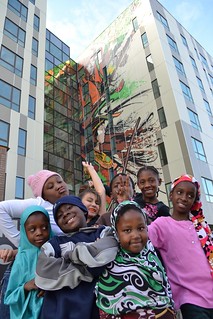
The team also conducted a thorough health impact assessment, covering not just the 17.5-acre redevelopment site but also nearby areas. Data on such topics as physical activity, obesity and heart disease, air quality and asthma, nutrition, traffic safety, noise, and mental health were collected from surveys, meetings, public agency data, and interviews. Three separate charrettes (structured, multi-day brainstorming sessions involving planners and community members) were conducted to inform the project on energy; transportation; and stormwater and green infrastructure.
There are more examples of good listening by architects. In leading the process to develop the award-winning Plan El Paso, the architecture and urban design firm Dover Kohl helped the city conduct a series of hands-on public planning workshops comprising over eight weeks of intense community exercises and discussions to generate the vision for the plan. This process was followed by over a year of regular meetings with a citizen advisory committee to refine a draft plan. A project website that also welcomed discussion received over 30,000 visitors, and the process received bilingual coverage in local and national media. (The internet and social media are evolving a new generation of tools for public engagement.)
For another example, the architects and designers who developed the vision for Seattle's mixed-use Thornton Place earned a standing ovation from a community meeting for their sensitivity to community issues while daylighting a long-buried stream and bringing green space to a neighborhood previously dominated by parking lots and other automobile-oriented uses.
In Columbus, Ohio, the architectural and planning firm Goody Clancy led a "Blueprint" process for revitalization of a low-income neighborhood that included "two years of community visioning, resident engagement, market analysis and collaboration among residents and the PACT partners—the City, The Ohio State University, and the Columbus Metropolitan Housing Authority, owner of two housing developments in the area." I could go on and on. I wake up every day thrilled to be working in this field right now.
I agree with Outram that there is some cold, unfeeling architecture out there, some of it celebrated in architectural circles. And I agree with her implication that architects, as with the rest of us, have an obligation to society. But where Outram and I differ is that I see architects as much a part of the solution as part of the problem. If your values are humanist, and you're not noticing and excited by the work that some of these great (and, I hasten to add, environmentally responsible) architects and designers are doing, then maybe you're the one who isn't paying attention.

